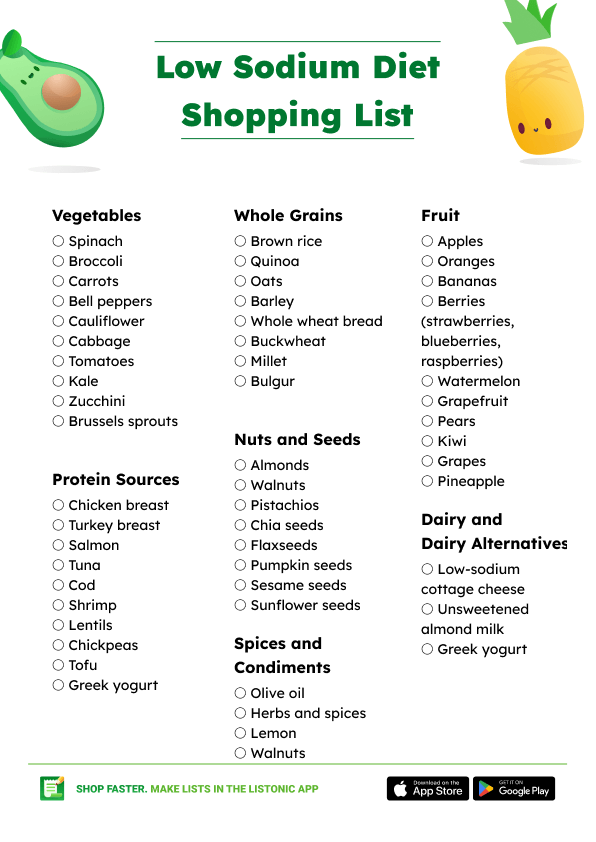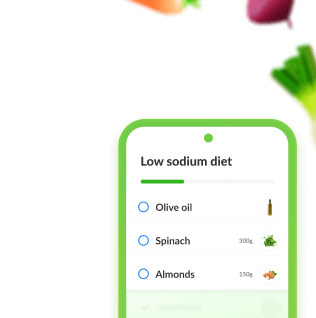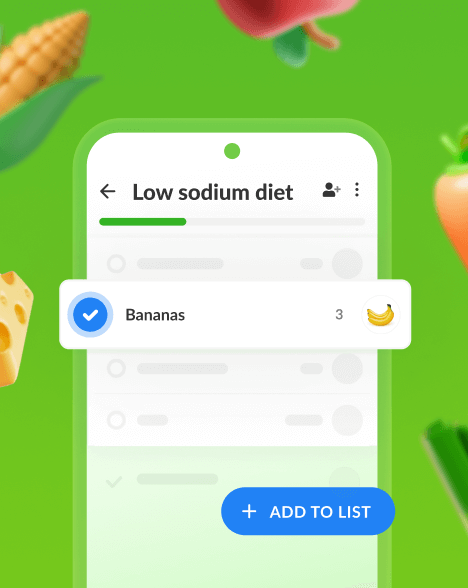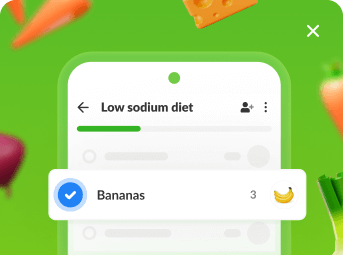Privacy Policy | Terms of services | Consent choices | © 2006-2024 Listonic. All rights reserved. Listonic Dev, and Listonic Ads are part of Listonic.
Low Sodium Diet Food List (+ Shopping List and PDF)
January 22, 2025
Start a healthier lifestyle with our in-depth guide to the low sodium diet. This 2025 article covers the basics of the low sodium dietary plan, uncovering its benefits and outlining key rules. From reducing sodium intake to incorporating nutrient-dense foods, discover what you can do to positively impact your well-being. You’ll also find a convenient shopping list below (along with a PDF) to ensure you have everything you need to start the diet right.
Table of contents
Low Sodium Diet Shopping List
Basic Guidelines for a Low Sodium Diet
Low Sodium Food List Breakdown
What Else to Keep in Mind?
Conclusions
Low Sodium Diet Food List
Vegetables
Fruit
Proteins
Whole Grains
Dairy and Dairy Alternatives
Nuts and Seeds
Spices and Condiments
Basic Guidelines for a Low Sodium Diet
Like the name suggests, the idea behind a low-sodium diet is to reduce the intake of sodium. It occurs naturally in numerous food products, such as processed foods and salt. The primary advantage of going on a low sodium diet is a decrease in hypertension that can develop into a heart attack or cerebrovascular attack at some point in life.
The diet also promotes proper kidney function, preventing fluid retention and potential damage. On top of that, research shows that this dietary approach can be helpful as a weight management strategy by reducing water weight. All in all, by consciously limiting sodium intake you can enhance your cardiovascular health, maintain healthy kidney functioning and overall well-being in 2025 and beyond.
Low Sodium Food List Breakdown
Vegetables
Vegetables are a cornerstone of a low sodium diet, because they are naturally low in sodium and high in essential vitamins, minerals, and fiber. Incorporating an array of differently colored veggies into your dietary meal plan not only enhances your overall eating experience, but also reduces chances for chronic diseases.
Fruit
Foods low in salt also include fruit, which possess natural sweetness, and are packed with vitamins and minerals that support good health. Whether snacking on them straight-up or blending into refreshing smoothies, these healthy bites will keep cravings at bay while offering essential hydration and nourishment.
Proteins
Add lean proteins like chicken breast, turkey breast, fish, seafood (or vege alternatives: legumes & tofu) to your low sodium grocery list. They provide essential amino acids while keeping sodium intake in check. These protein options are versatile and can be incorporated into various dishes, supporting muscle health and giving you a feeling of satiety.
Whole Grains
Whole grains like brown rice, quinoa, oats, and whole wheat bread are nutritious sources of carbohydrates, fiber, and various minerals. Choosing them instead of refined grains helps to maintain a low sodium diet and promotes heart health. They provide sustained energy, aid in digestion, and help regulate blood sugar levels.
Dairy and Dairy Alternatives
While dairy products can be higher in sodium, selecting low salt foods or entirely unsalted options like low sodium cottage cheese and unsweetened almond milk can still provide essential nutrients without excessive salt intake. These alternatives can contribute to bone health, provide calcium, and offer a source of healthy fat.
Nuts and Seeds
These healthy snacks offer essential fatty acids, protein, fiber, and various vitamins. Opting for unsalted varieties ensures a lower sodium intake and doesn’t stop you from enjoying their nutritional benefits. Apart from numerous nutrients and a satisfying crunch, they also keep your heart well.
Spices and Condiments
These items can add flavor to your meals without relying on excessive sodium. Olive oil, herbs, and spices are great alternatives to salt. Low sodium mustards, salsas, and soy sauce add flavor without compromising your low sodium goals. They can also help you take your culinary creativity to the next level.
Low Sodium Diet Shopping List
Vegetables
Spinach
Broccoli
Carrots
Bell peppers
Cauliflower
Cabbage
Tomatoes
Kale
Zucchini
Brussels sprouts
Fruit
Apples
Oranges
Bananas
Berries (strawberries, blueberries, raspberries)
Watermelon
Grapefruit
Pears
Kiwi
Grapes
Pineapple
Proteins
Chicken breast
Turkey breast
Salmon
Tuna
Cod
Shrimp
Lentils
Chickpeas
Tofu
Greek yogurt
Whole Grains
Brown rice
Quinoa
Oats
Barley
Whole wheat bread
Buckwheat
Millet
Amaranth
Bulgur
Farro
Dairy and Dairy Alternatives
Low sodium cottage cheese
Unsweetened almond milk
Low sodium cheese
Plain yogurt (low sodium)
Greek yogurt (low sodium)
Nuts and Seeds
Almonds
Walnuts
Pistachios
Chia seeds
Flaxseeds
Pumpkin seeds
Sesame seeds
Sunflower seeds
Spices and Condiments
Olive oil
Herbs and spices (garlic, basil, oregano, turmeric, cinnamon, etc.)
Vinegars (balsamic, apple cider, red wine)
Low sodium mustard
Low sodium salsa
Unsweetened nut butter
Low sodium vegetable broth
Unsweetened canned pumpkin puree
Lemon juice
Get a Low Sodium Grocery List on Your Phone!
Add & remove items
Sort items by store aisles
Share the list with your partner
What Else to Keep in Mind?
What Foods to Avoid?
When following a low sodium diet grocery list, it is important to be mindful of certain categories due to their high sodium content.
Processed Foods: such as canned soups, pre-packaged meals, and snacks, are often high in sodium. They are typically manufactured with added salt for flavor and preservation purposes, making them important items to avoid or limit on a low sodium diet.
Fast Food: so burgers, fries, pizza, and sandwiches, tend to be loaded with sodium. These convenient options are often prepared with pre-packaged ingredients and condiments that are high in sodium content.
High Sodium Condiments and Sauces: watch out for soy sauce, ketchup, salad dressings, and barbecue sauce. These flavorful additions can quickly contribute to daily sodium intake. Opting for low sodium or sodium-free alternatives (or making homemade versions!) can keep you on the right track.
Baked Goods: Many commercially produced baked goods, including bread, pastries, and cookies, may contain added salt for flavor and texture. Checking nutrition labels and selecting low sodium or sodium-free options is a must.
How Much Sodium Do I Need?
To promote optimal health in adults, it is typically recommended to keep daily sodium intake below 2,300 milligrams (mg), which is equivalent to about one teaspoon of salt. However, based on certain medical conditions such as high blood pressure, kidney disease or heart disease, the advised limit may need to be lowered even further to around 1,500 mg.
While managing your sodium consumption holds great importance from a health standpoint, it's critical not to fall short on getting enough of the mineral either, because sodium aids in proper fluid balances regulation, nerves functioning and muscle contractions.
By opting for a low salt diet that is consistent with professional guidance, most people are able to maintain sound health.
Low Sodium Tips
Read Food Labels: Be mindful of the sodium content listed on food labels. Look for products labeled "low sodium," "reduced sodium," or "no added salt." Compare different brands and choose options with the lowest sodium content.
Cook and Prepare Meals at Home: By cooking meals from scratch, you have greater control over the ingredients and sodium content. Use fresh, whole foods and season with herbs, spices, citrus juices, or salt-free seasoning blends to enhance flavors without relying on salt.
Be Mindful of Condiments and Seasonings: Many condiments and seasonings can be high in sodium. Look for low sodium versions or try making your own sauces, dressings, and marinades using fresh ingredients and salt-free seasonings. Experiment with herbs, spices, citrus, and vinegars to enhance the taste of your dishes.
Limit Processed and Packaged Foods: as mentioned before, they tend to be high in sodium. Opt for fresh, whole foods instead and minimize your intake of canned soups, sauces, snacks, and ready-to-eat meals. When purchasing packaged foods, choose low sodium or sodium-free options.
Conclusions
Adopting a low sodium diet in 2025 can provide an affordable and simple solution to effectively manage various health conditions. By reducing sodium intake and avoiding certain high-sodium foods, you can potentially reduce the chances of developing heart diseases or sustaining high blood pressure issues, which eventually leads towards better cardiovascular health along with effective kidney functionality maintenance alongside fluid balance control.
To help you start the low sodium diet quicker and easier, we’ve included the whole grocery list for you to use, along with a PDF version. To edit the items, add notes, or share the list with your shopping partner, get our free shopping list app on your phone.




